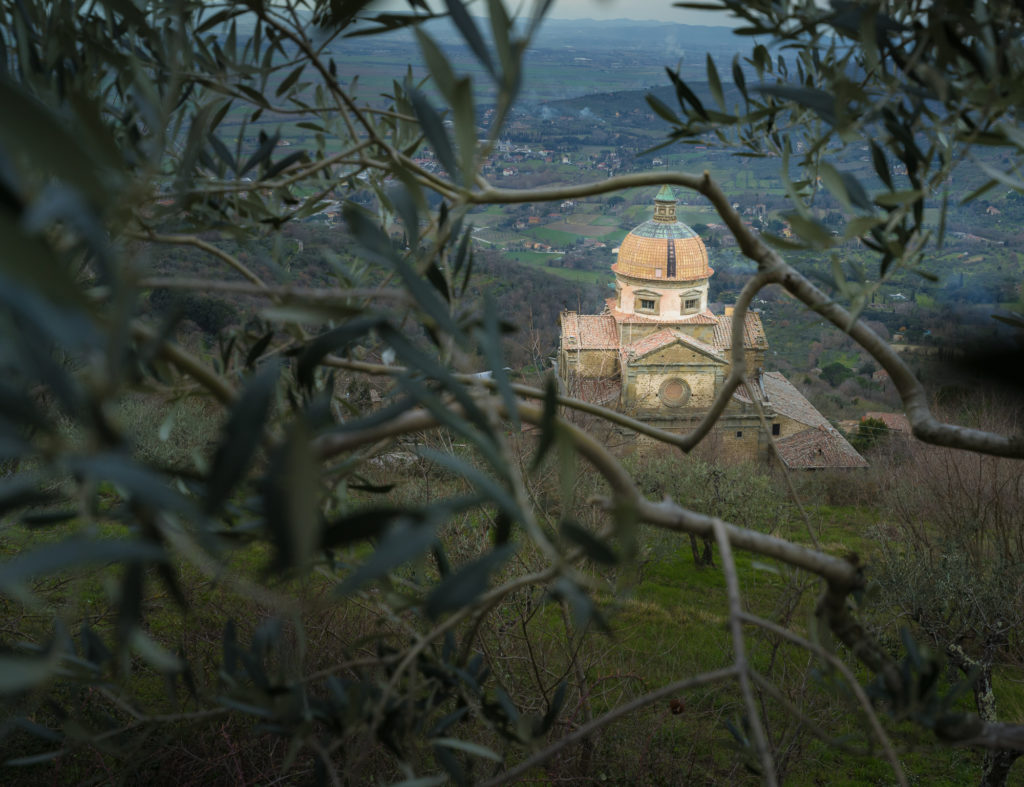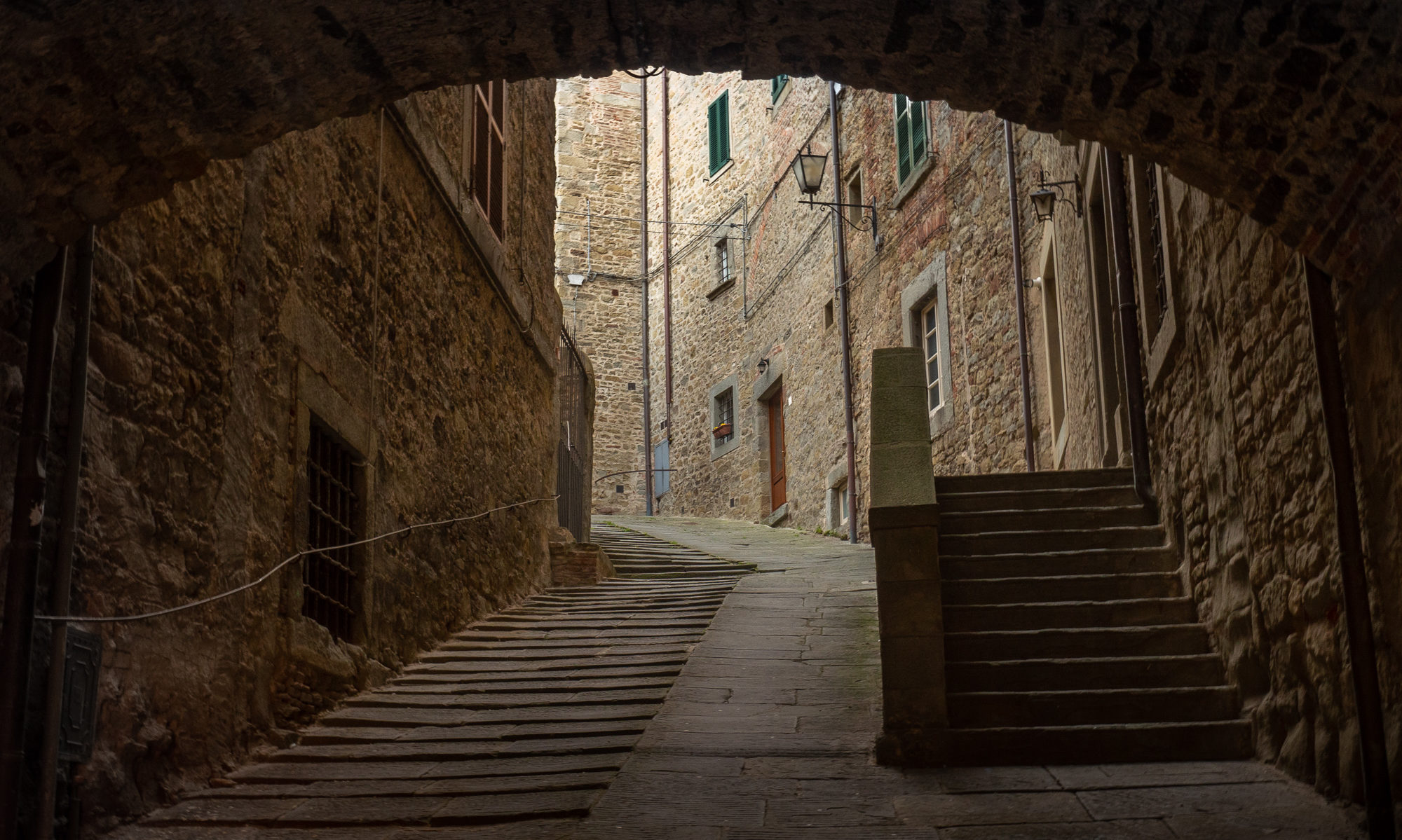Having been here beforehand, my wife Mary Pat and I have chosen to stay in Cortona, Tuscany during the coronavirus outbreak. I’m writing these journal entries to describe our experiences here in this small hilltop town. We are “Stuck” – but happily and by choice.
Quaranta Giorni – Forty Days
As reported in my last journal entry, after nearly three weeks of staying at home in Cortona, Mary Pat and I are now staying at home in Wisconsin. The view out the windows has changed, and the things we can do each day can happen in a couple more rooms, but, with a few small variations, quarantine is quarantine, regardless of the locale.
The practice of quarantine began in 14th century Venice in an effort to protect that important port city from plague epidemics. Ships arriving in Venice from infected ports were required to sit at anchor for 40 days before landing. Forty days in Italian is quaranta giorni, but in the Venetian dialect it became quarantena or anglicized, quarantine. The goal, of course, was to make sure that anyone carrying disease would manifest the symptoms before bringing them ashore with them and infecting others.
Like thousands of my education colleagues around the country, I am meeting with my University of Georgia Studies Abroad students via video conferencing. It’s a poor substitute for meeting with them live and in person, but they are moving forward and learning some of the essential elements of the medium of photography. A challenge has been to move their thinking from the “exotic” subject matter they found outside their doorstep in Cortona to what they consider to be the more mundane subjects that they find in their homes and their hometowns.
But their quarantine – and mine – have given all of us a chance to think about where we are, how we live, what what we value. A portrait assignment, which in Cortona would have been of people they had met in that town, now becomes portraits of their immediate family. How many of us would relish a carefully considered portrait that we ourselves made of our parents or our siblings? I’m hoping that they will come to see these images as being even more rich in content than what they might have photographed in Italy.
As the virus continues to change the lives of people all around the world, those of us who are healthy and following the recommendations of being apart from our regular world can use this time to take stock of what we do in our everyday lives. Whether it’s 14 days or 40 – we have some time; what will we do with it?
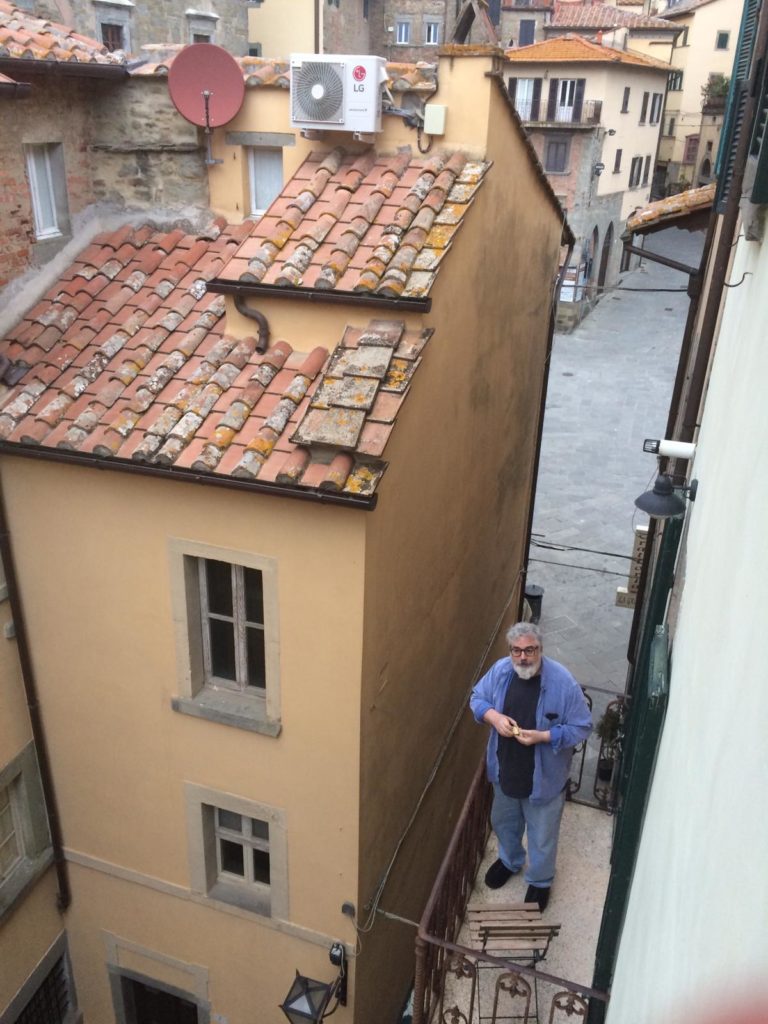
Photograph by my faculty colleague (and upstairs neighbor) Jeni Hansen
Restiamo a Casa – We Stay At Home
With two long days of travel behind us, we are now at home in Wisconsin, where we’ll stay. The CDC mandates that anyone who has traveled to a “high incidence” country must do a mandatory self-quarantine for fourteen days. Fortunately, family members were kind enough to lay in supplies for us before we arrived home last night, so we are all set, at least for the short-term. As luck would have it, we already had plenty of toilet paper before we left for Italy 53 days ago.
According to the news reports this morning, our fourteen days of quarantine will be supplanted by a new “Safer At Home” order by Tony Evers, Wisconsin’s governor. Our state has already had some social distancing orders in place, from limiting sizes of gatherings to closing of non-essential businesses, but now we have in place what I consider the most important strategy to help suppress the spread of the virus – don’t leave your home.
So, we have traded the Italian stay at home mandate for the Wisconsin variant – a “Negroni and a cabonara” for a “Brandy Old Fashioned and a fish fry.” I have a preference, but there is a time and a season for everything under the sun.
I’m hoping that all the areas of the U.S. begin to understand that the only way we can begin to contain the virus is to keep transmission from one person to another to the minimum and that we’ll all resist the temptation to break our own self-isolations and begin to stem the tide. Nationally, the Italians have employed the hashtag #restiamoacasa – “we stay at home.” I wish we had a similar national rallying cry here in the United States.

When In Rome… And New York
Shortly after we arrived in Rome yesterday, we read reports that Italian Prime Minister Conte has ordered a shut down of all internal travel – banning the sort of trip we took from Cortona. Timing is everything, I guess.
As we had seen yesterday, Rome’s Leonardo Da Vinci (usually referred to as Fiumicino, after the city west of Rome where it’s located) airport was a very quiet place this morning. All terminals have been closed except for one, where a few domestic and even fewer international flights are arriving and departing this week.
Everyone in the airport, travelers and employees alike, were outfitted with masks and latex gloves. It seems like this is “the new normal” and that our public lives will involve isolating ourselves from others for some time to come. One of the things that is important to note is that this protection is as much about protecting your neighbors – no matter how distant- as it is about protecting you.
Before going through the standard security check, we were asked to fill out a form that asked some simple coronavirus-related health questions: had we had any of the three major symptoms of cough, fever or difficulty breathing. The form also asked if we had been near anyone who had tested positive for the virus, and then what flight we were taking and seats on that flight we were occupying.
After security and before Italian passport control, our temperatures were taken with an infrared thermometer and then matched up with a photograph of our faces. We passed with normal temperatures.
On the flight itself, we were asked to wear masks for the whole ten-hour trip, except when eating or drinking. The trip itself was normal in that way modern coach-class travel has become with terrible food and slightly outdated movies. One variation from that norm was that the airplane was only about one-quarter full, so it was easy to maintain a safe social distance from other passengers.
When we arrived in New York city’s John F. Kennedy airport, we were met on the jetway by a group of police and healthcare workers, who again took our temperatures (again fine) and collected another form that we’d been given during the flight. Similar to the departure form, it asked whether we’d been in a high coronavirus incidence country, reminded us that we were obligated to self- quarantine for fourteen days and asked for the address of that quarantine location.
Once we exited the Jetway, it was clear that we had left Italy and had entered the United States. In Italy, from small towns like Cortona to the big city of Rome, it was rare to see anyone with out a mask and gloves. At JFK, perhaps 20% of the people were wearing that protective gear, and no one appeared to be maintaining any sort of a safe distance from one another. I remarked to Mary Pat that it was as if the people there were not aware that they were living in the U.S. epicenter of the pandemic.
It’s as if the experiences of Italy and other eurozone countries have had no instructional effect and that “life as usual” is an effective response to this terrible situation. Could this attitude be a result of the mixed messages this country has sent its citizens as the virus advanced on our shores? During our layover in New York, I saw two reports that at least partly define this contrast in response between Italy and America. One was that, while Italy reported many new cases of Covid-19 and many new deaths from it, the rate of that increase appears to be slowing. The other report was that the number of Covid-19 cases and deaths had increased dramatically in the U.S. in the previous 24 hours. Social distancing and isolation work. They may take time, but they work.
Sitting in the departure gate lounge, we saw a live coronavirus news conference starring Donald Trump. In addition to the now-expected superlatives, lies, self-praise and misinformation, the president of the United States said that he thought that perhaps the country should let people go back to work and school at the end of the fourteen day stay at home directive – it would be better for the economy. While we know Trump ties a successful economy to his own personal success, is it worth letting Americans die for a higher number on the Stock exchange? Will Trump feel good about himself when the U.S. is #1, but this time it’s in Covid-19 deaths?
This terrifyingly difficult time requires strong, capable, data and science-based leaders. Around the world, many heads of state are leading in just that way. Tragically, Donald Trump is not among them.
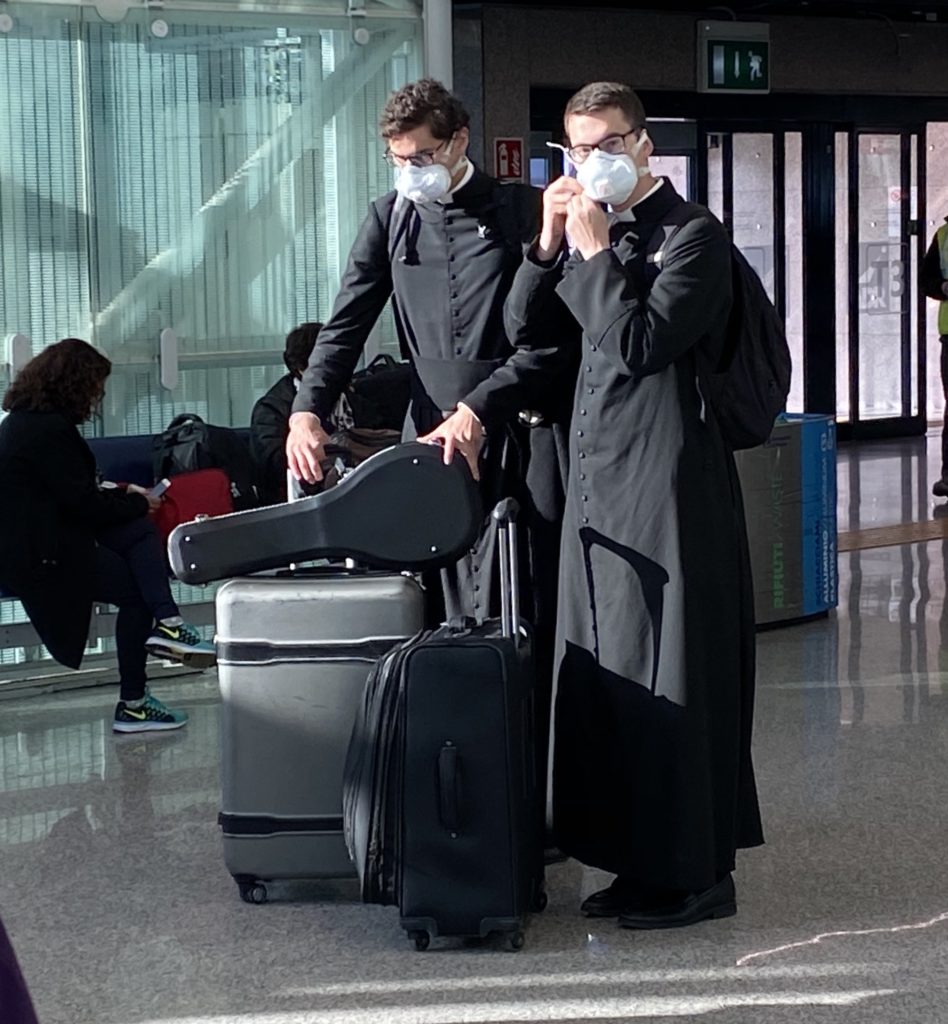
Tristezza (Sadness)
Today’s overarching emotion is sadness.
Early this afternoon, with our bags in tow, we walked out into Cortona’s Piazza della Repubblcia. There were only three of us in the normally bustling piazza – Mary Pat and I and Luca, the Cortona-based driver who we had hired to take us to Rome’s Fiumicino airport. We had considered using the train from nearby Camucia, but thought that a car would offer less exposure – less risk.
Before we got into the van, the gloved and masked Luca gave us hand sanitizer and then asked us to get into the very back row of the vehicle. He explained that while he was permitted to drive us, there was a new “distancing” rule that allowed only two passengers in the car, and they had to be separated from the driver by at least two meters.
As we rolled down from Cortona’s steep hillside location, we saw no one. Mary Pat and I looked at one another and were overcome with sadness to leave – not only what we’ve come to think of as a home away from home, but the people there who we know are struggling through this experience of navigating through unknown waters.
Luca’s route took us down through an empty Camucia, then to an empty Bettole, where we got onto an empty A1 Autostrada. Anyone who has ever driven or been driven in Italy has likely been on this major artery that connects Naples to Rome, Rome to Florence and Florence to Milan. On what is normally a crowded, high-speed motorway, there was our van and handful of trucks. As we approached Rome and the G.R.A. ring road around the city, I thought we might see more vehicles – and we did, but only a few dozen. Likewise, as we approached the airport itself, there were almost no cars in either arrivals or departures.
We checked into the airport hotel, our “holding point” before our flight tomorrow. At the registration desks, plexiglass shields have been erected between the clients and the gloved, masked hotel employees. We checked in, got to our room and felt more than a little adrift. We recognize that tomorrow’s flights home and the three airports we’ll encounter (FCO to JFK to ORD) will offer our greatest exposure to the virus since we left Cortona.
Yesterday, we had spent some time saying goodbye to our friends in town. There were a few that we could see in person; the Fratoni green grocery family, the Molesini grocery store family (and their fantastic deli ladies) and Mario the florist. The rest were done remotely through messages, texts and video chat.
An actual highlight of our last night in Cortona was getting together via Zoom video chat with Kris, Mark and Jeni, three of our University of Georgia Cortona family who are still in town for a “virtual aperitivo” hour. Sharing that time, even via a tiny video screen, brought at least a little humanity back to our lives.
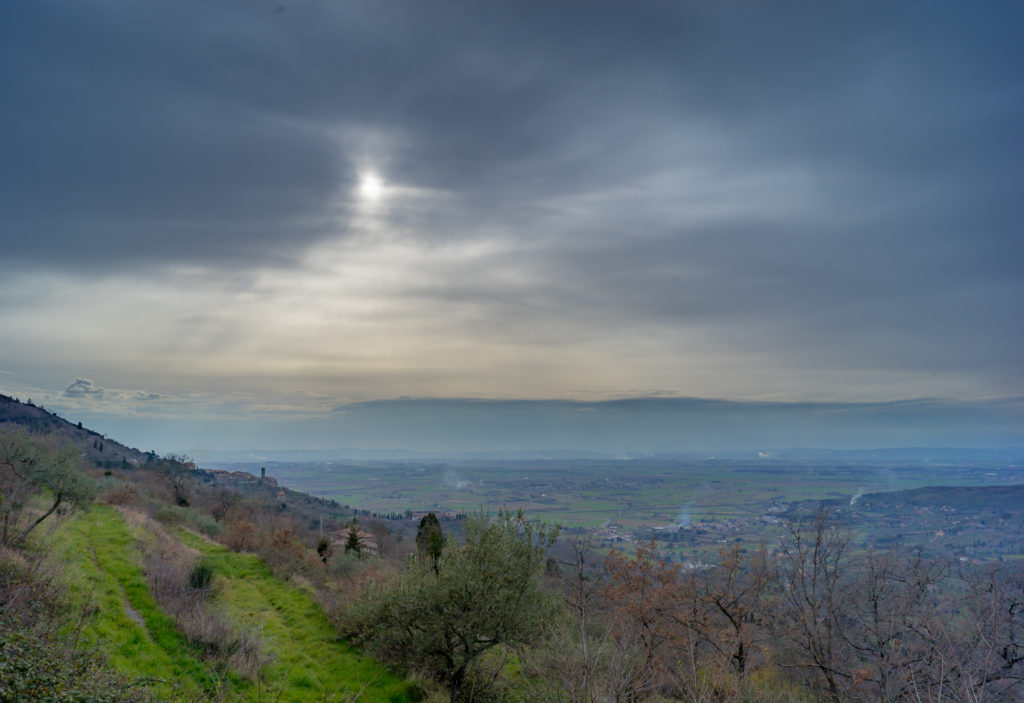
Fuori dalla Padella (Out of the Frying Pan)
On Thursday, March 19, the U.S. State Department raised the travel advisory to Level 4 – their highest warning. The statement on their website is: “U.S. citizens who live in the United States should arrange for immediate return to the United States, unless they are prepared to remain abroad for an indefinite period.“
While we love our adopted second country, as an Italian friend, recently returned from the U.S. said, “It’s time to be where we officially belong.” we know that we can’t be here for “an indefinite period,” so we have made the difficult decision to leave Cortona and head home to the United States. We fly out of Rome on Monday, March 23 and should be back in our home in southern Wisconsin by late Monday night.
Going from an environment where, if we went to the grocery store, we might see or interact with four or five people to navigating through three airports and being with hundreds, if not thousands of other people is certainly a bit daunting. Combine those fears, with what we see happening in the U.S. as the virus spreads and infection rates grow there, we feel as though we are stepping out of the frying pan and into the fire.
But, with a U.S. president who is angered when asked a softball question about what he’d say to Americans who are scared, we face the very real possibility that the U.S. borders may close at any minute and we think it is prudent to get home. Like everyone else in the world, we hope that there is a light at the end of this tunnel.
Now, to pack up our apartment, and, from a distance, say goodbye to all our friends here in Cortona. Noi torneremo (we will be back).
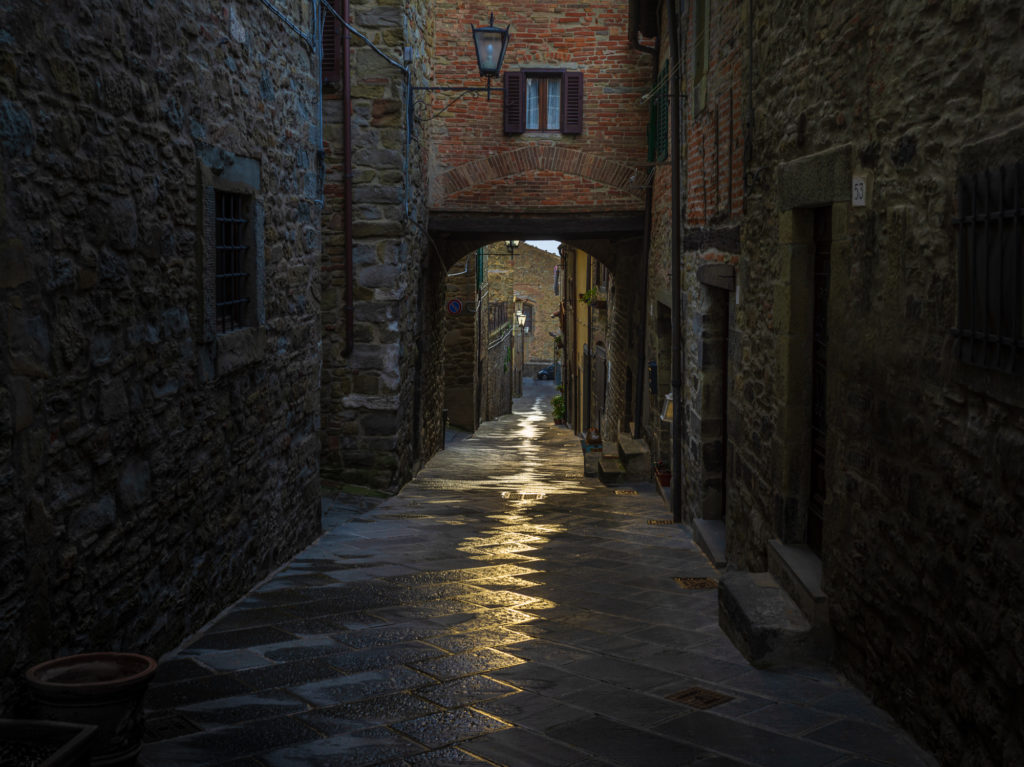
Pride & Sacrifice
“We all must give something up for the good of Italy, There is no more time.”
These were the words of Italian Prime Minister Giuseppe Conte during his March 9 announcement to put the whole country on “lockdown.” This was an unprecedented move; one that had not been invoked since WWII, but the Italian government felt it was in the best interests of the nation to do so.
Not only did Conte give the order for everyone to stay home, he also canceled all sports gatherings across the country, urging citizens to keep the common good at the top of their minds and help control the spread of the coronavirus.
Now, I know that Conte is, like many other politicians, loved by some, reviled by others, but what has impressed me is that this leader did something: he led.
And, by and large, people followed. The infection numbers have not started to tail off yet, but the hope is that containment will help flatten that curve. While fighting an unknown foe, doing what is right is usually the answer.
We’ve seen reports of lack of compliance in the larger cities, but in this small town of Cortona, it’s fairly evident that everyone has complied with the directive to “restate a casa” – stay at home. This, even though it is affecting the livelihood of thousands of people whose shuttered businesses are providing them with no income. Yes, there have been monetary concessions made, but it will take time for the Italian economy to recover from this blow.
Even though the streets are empty during the nighttime hours, the front of Cortona’s Palazzo Comunale is now lit up each night with the “tricolore” – the green, white and red stripes of the Italian flag. Most will only see it in photographs, but all will understand the solidarity that it represents.
In my many years of travel here, I’ve learned about the Italian’s strong sense of national pride. However, Italians understand that their little peninsula is one small part of a larger continent and an even larger world. My Italian friends have an innate understanding that we are all in the world together. So, people here see that staying home is not only for their own good, but also for the good of their neighbors, their friends, their country and their world – our world. It’s a mutual trust that we all will do what is right for each other.
The contrast between what has happened here and what we are reading about our own country has not been lost on us. Italy has a leader who took charge and made hard decisions in the light of facts and science. And, even though the U.S. president Trump has now decided that he thinks this is serious, he spent weeks denying, downplaying and, as his wont, patently lying about the situation. These were weeks where there should have been action, not denial. Was no one looking at what was happening here in Italy?
Trump has already hurt my country in so many ways, ranging from regressive environmental policies and rejection of the threat of global warming to division and polarization of the citizenry. His denial of what he initially called a “hoax” – the very real novel corona virus – has lost us precious time and likely even more precious lives. Moreover, it sickens me to see a global problem turned into a nationalist issue as Trump tries to figure out ways to blame others for his failings as a leader. Accepting no responsibility is not a primary trait of a leader.
Part of why I started this journal was to track what was happening here for my friends back home so they could track what happens – even in a country with world-class healthcare and sound leadership. Of course, I’m just one little voice in a large crowd of warnings coming from Italy about what happens when you don’t take a global threat seriously. Get off the beaches in Florida, stop meeting your friends for lunch, stay at home and do your part for the good of us all.
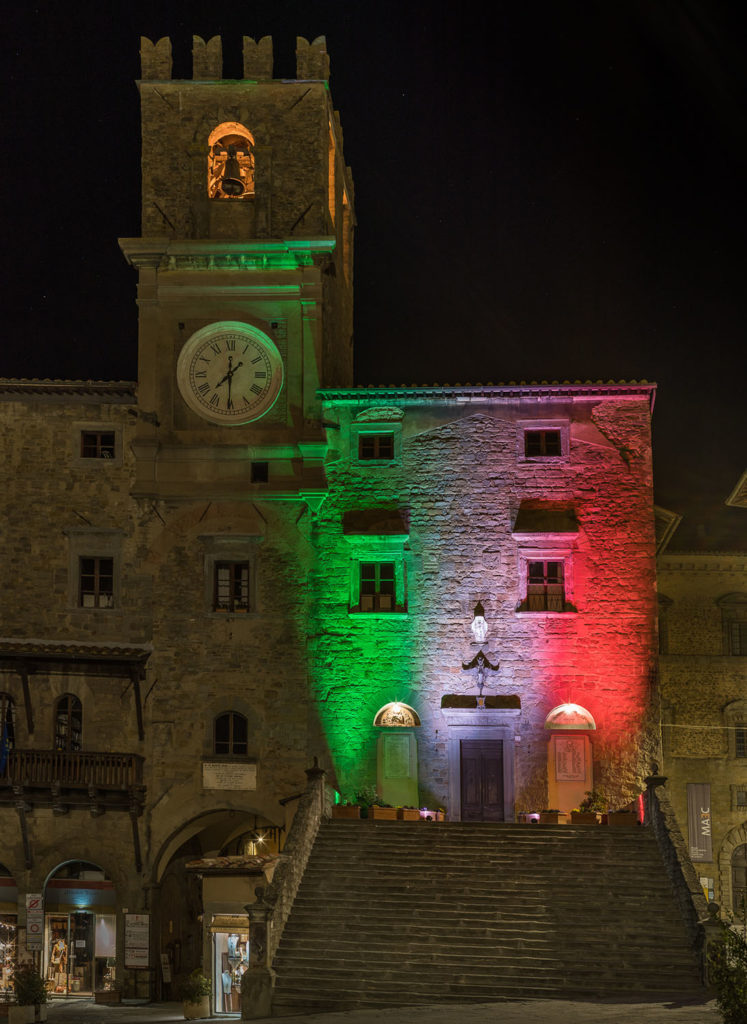
Silenzio
The chatter is gone.
The last time we were in Cortona for the University of Georgia’s Studies Abroad program, we rented a lovely little apartment; so lovely that we selected it again for this semester of teaching. Among the many reasons we loved it was that it was just off the main Piazza della Repubblica, one of the three main piazzas (squares) in the town. It has two tiny little balconies and from them, there is a narrow view into the piazza.
With the balcony doors open, as they usually are in warmer weather, there is always a delightful hum of the voices of people coming and going. There are several benches in Piazza della Repubblica and of course the steps of the Palazzo Comunale (town hall). These broad, well-worn stairs have welcomed people to Cortona since medieval times.
Like in most of Italy, Cortona’s piazzas act as the town’s living room. All day and into the night, people stroll, stop to chat, pass through as they go about their shopping or have a coffee at one of the several bars nearby. The piazza is a living, breathing space; as integral a part of the Italian culture as is pasta.
But now, in the piazzas, the steets and the little vicoli of Cortona, where you once heard the sound of voices in conversation, there is nothing. The stairs, typically filled with people sitting, relaxing, enjoying a gelato, are empty. Even during the time when people are going to and from the grocery, it’s quiet. Occasional conversations are heard, but they are rare and brief. From the balcony, I can watch people purposefully steer clear of one another, as they work to keep their “un metro” distance.
I’m looking forward to the day when this abnormal silenzio is replaced by normal conversazione.
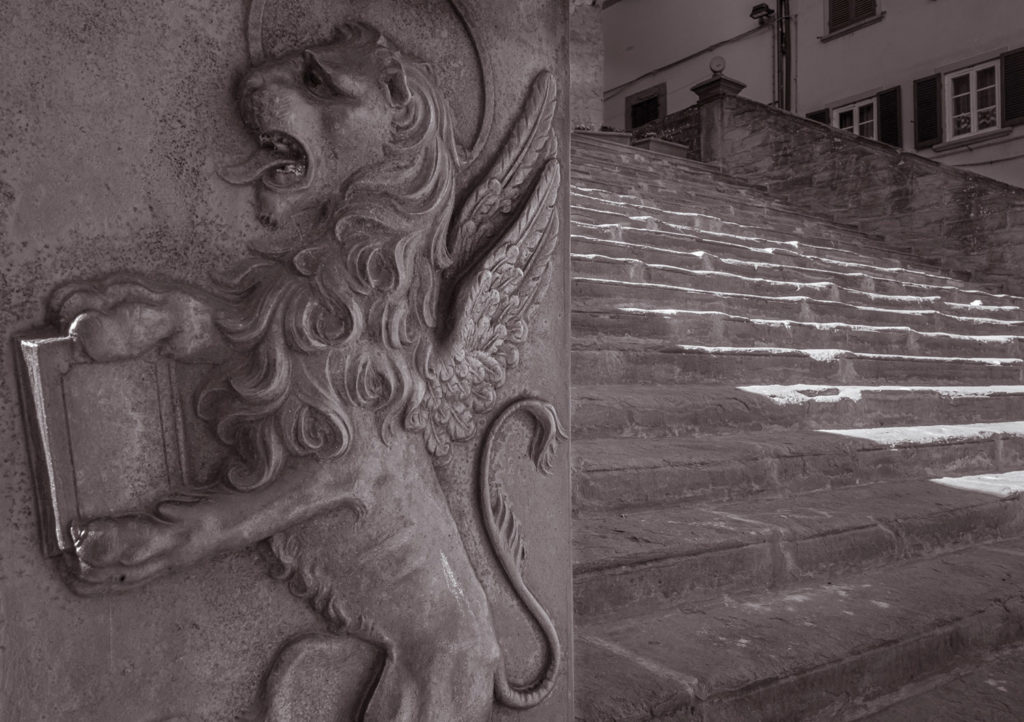
Lining Up At The Grocery
We’ve seen the photographs of the long lines both inside and outside the supermarkets in the U.S. as people stock up for “hunkering down” (what is being called “restate a casa” or “stay at home” here).
Groceries are among the few stores that are open throughout Italy during the novel coronavirus outbreak. Of course in big cities, there are large grocery stores, but here in small-town Cortona, there are just a few very small groceries.
The grocery that we frequent is Molesini Market, a genuine “mamma e papa” business, run by, you guessed it, the Molesini family. We’ve always shopped there in the previous times we’ve been in Cortona and it is especially convenient in that the apartment we’re renting is about 60 feet from the store’s front door.
Molesini Market is perhaps 25 feet by 15 feet and includes a full deli, a selection of some meats, wines, beers, pasta (of course), household items and pretty much all anyone would need to cook meals at home – all in a space of under 400 square feet.
Because the space is so small, and because the Italian government has mandated that everyone should stay “un metro” (one meter) apart from one another, the store has established a policy of only 3 people inside at one time. So… lines develop. The most I’ve seen is perhaps 6 or 7 people, but typically it’s just 2 or 3.
With everything else closed, it’s just about the only place we go.

Italians – 10 Days Ago
Quarantined Italians record messages to “themselves from 10 days ago” during the Coronavirus pandemic.
The truth is… well… it’s in the video. This disease spreads quickly and without prejudice for age, gender or social standing and the fewer human interactions we have with each other – worldwide – the better our chances of managing this crisis.
On Facebook, I’ve seen people in the U.S. criticizing the “socialized” healthcare here in Italy because of the terrible problems that are happening in the north of the country, where doctors are triaging patients based on likely survival rate. It’s not about the system of healthcare, it’s about healthcare specialists recognizing that they are in a war, and in a war, there are decisions that must be made as resources get stretched thin. Italians in those hard-hit northern cities are applauding their healthcare workers for trying as hard as they are to save the lives that they can save.
I do worry, though, about the U.S. and about the people there that do not have health insurance. Will they get tested and how will they get treated if they need treatment? My Italian friends are dumbfounded that regular healthcare costs money for U.S. citizens, let alone care in emergency situations like this. This, to me, is where a nationalized healthcare system could really be useful in America – making sure that everyone, no matter what their situation, has access to life-saving measures.
For us here in Cortona? We “restate a casa” – stay at home as this nation – and the rest of the world – tries to flatten the curve.
Lido The Poet
Lido owns a restaurant here in Cortona, Croce del Travaglio. In fact, it’s one of our favorite places to go – a small, family-run place with fantastic Tuscan dishes and heavenly wood-fired-oven pizzas. His restaurant, like all in Italy right now, is closed as we all stay at home.
One of the things that I’ve learned about Italians is that, by and large, they are not really defined by the jobs they do. Rather, their humanity and capacity for seeing a different perspective is the thing that they carry with them to their day-to-day lives. Lido is just such a man, a poet who also serves great food.
Below, I’m posting (with Lido’s permission) a piece that was published in L’Etruria, a newspaper that covers this southeastern corner of Tuscany. Lido wrote it after a walk near Santa Maria Nuova, just before we were all confined to our homes here. I thought it was worth reading. (I’ve had Google translate from the Italian and edited a bit for English clarity):
“This afternoon I spent in my valley, with the excuse of wild asparagus, which I didn’t find on time; but I didn’t look for them too much.
“Instead, I sat looking at the landscape, and the houses, remembering all the friends who lived there, when as if by magic my gaze stopped on one: it was the home of the old sage Attilio Ricci, for me an added grandfather who loved me very much.
From here a story came to my mind which he told me on a stormy evening during which I was afraid.
The wild man!
“He sat in front of the large hearth where large logs burned, crackling, and made me cuddle between his legs and said to me:
“‘Once upon a time a wild man lived in a large forest. During the summer when he could stay warm and dry, he would eat succulent berries, game, and all the fruits that the forest gave, but he was sad and worried because everything it could not last.
Instead, he was happy in moments of thin, famine, frost and snow because he thought that everything could only improve.’
“I felt light-hearted! And it is with this that I give you a good evening and a good night.
“Dear friends, do not think of me as unaware – someone who does not worry. But weeping is useless, if this true story that happened to me as a child makes a person feel a little more serene, I would be happy.”
– Lido Rossi
Lido – as soon as you reopen, we’ll be in for a pizza.
